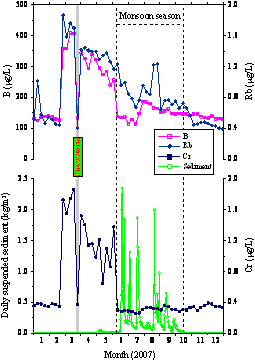During recent decades, anthropogenic activities have introduced significant amounts of trace elements into the aqueous environment via runoff and/or direct atmospheric deposition. Trace elements hold great potential for understanding geochemical processes because of their individual sources or characteristic behaviors. Importantly, anthropogenically derived trace elementsin watersmay exceed the standards established by various national governments for the protection of aquatic life and for drinking water,some toxic or harmfulones having significant effects on biological vitality and toxicity. Therefore, understanding sources, flux and variation of trace elements is very important in understanding environmental processes and health effect on the living beings. As the largest, hydrologically closed lake on the Tibetan Plateau and one of famous Wetlands of International Importance, Lake Qinghai receives naturally- and anthropogenically- derived materials from the catchment and atmospheric deposition. However, knowledge about sources, flux and seasonal variation of trace elements, in particular potentially harmful metals, into Lake Qinghai is sparse.
Prof. Jin Zhangdong of Institute of Earth Environment, CAS and his NCKU (National Cheng Kung University, Taiwan)colleagues firstly demonstrate trace element background and variation of river waters in the semi-arid area where human activities are limited, on the basis of high precision ICP-MS trace element measurements of water samples collected seasonally from the Lake Qinghai catchment. The main concluding remarks include:
1. The primary flux of dissolved Al, B, Cr, Li, Mo, Rb, Sr and U is attributed to the inputs derived from both rock weathering and atmospheric processes: Cr, B and Rb are strongly influenced by eolian dust input during the springtime, indicating that eolian dust makes a significant contribution to river water chemistry, and Li, Mo, Sr and U are also influenced by weathering processes sensitive to monsoon conditions;
2. Nearly all river water samples contain dissolved trace elements below the WHO regulations for drinking waters, with the exception of As and B in the Daotang River water samples collected in late July probably mobilized from underlying lacustrine sediments;
3. The potentially harmful metals (Co, Cu, Ni, Pb and Zn) have higher concentrations in the monsoon season due to pollutant sources from the east and/or a runoff washout when the discharge is high. A total of 38.5±3.1 tons of potentially harmful elements are transported into the lake annually, despite human activities within the catchment being limited.
Related paper entitled “Sources and flux of trace elements in river water collected from the Lake Qinghai catchment, NE Tibetan Plateau” byJin Z D, You C F, Yu T L & Wang B S is in press on Applied Geochemistry.


 © 2015 Institute of Earth Environment,CAS
© 2015 Institute of Earth Environment,CAS Address:No. 97 Yanxiang Road, Xi'an 710061, Shaanxi, China

 Location :
Location :